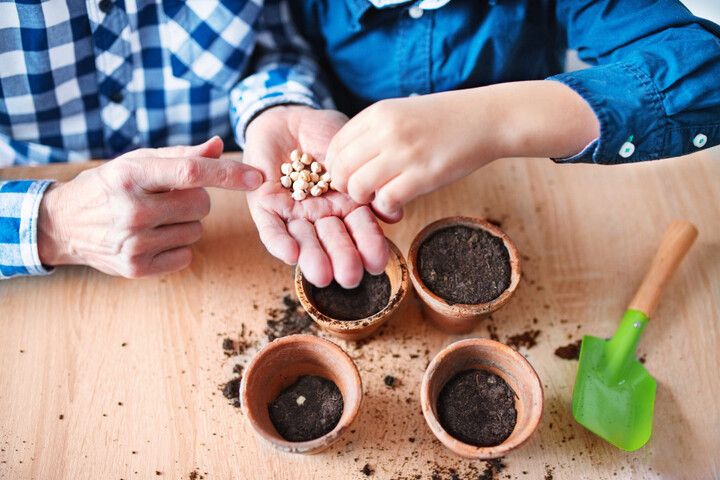The pandemic sprouted a newfound interest in gardening. For those who want to do even more with their gardens in 2021, saving seeds can add another level of fun.

Seed saving allows gardeners to still grow their favorite varieties. It also lets people develop better fruits and vegetables over time. And as we found out during the early months of the novel coronavirus pandemic, you can’t always rely on a favorite seed company or nursery to come through.
“Last spring, so many seed companies actually ran out of stock, had to shut down their websites,” said Bevin Cohen, author of the book “Saving Our Seeds: The Practice & Philosophy.” “People were buying seeds unlike ever before and to me that highlights the need to save seeds more than anything else.”
Cohen said that when you buy seeds from a seed company, it’s a little bit like hitting a reset button on your garden: The plants that you grow from those seeds aren’t necessarily adapted to your growing conditions.
But if you grow multiple plants of the same tomato variety, for example, and one is doing much better than the others, you can save the seeds from that one and start the process of growing plants that are specialized for your area.
“These plants adapt to the way you grow them, to your microclimate, to your soil, to the pest pressures, and they’ll continue to perform better year after year when you save the seeds from the healthiest, strongest, best producing plants,” Cohen said.
Brijette Peña, owner of the San Diego Seed Company, said that the company was founded on the premise of providing regionally adapted seeds. Her company saves, trials and sells seeds that are acclimated to zones 9 and 10 (which includes Southern California and parts of the Southwest)
“Prior to the 1950s, all seed was regionally adapted because seed didn’t travel as far and every area had a local seed company that would basically do the work that we’re doing now,” she said.
Beyond just acclimating a plant for your microclimate, you can select for traits that you want to see over time, including size, flavor, color and maturity time, said Cheryl Moore-Gough, author of “The Complete Guide to Saving Seeds: 322 Vegetables, Herbs, Fruits, Flowers, Trees, and Shrubs.”
“It’s just a question of you getting out there and selecting what is best for you,” Moore-Gough said.
How to save seeds
First, the seeds need to be removed from the fruit or vegetable, via either wet extraction or dry extraction, said Randel Agrella, a senior horticultural specialist for Baker Creek Heirloom Seeds.
Dry extraction involves removing already-dried seeds from their casing. Dry extraction plants include beans, peas, grains and flowers. For peas and beans, wait for the outside shell to dry completely on the plant, then simply break it apart to remove the seeds.
Some winter crops that California gardeners will soon be able to extract the seeds from in the coming weeks include lettuce and cilantro, Peña said. Once those plants make flowers and the flowers have dried, you can extract the seeds.
Wet extraction involves removing seeds from a wet material and giving them time to dry before storing them. Think plants such as tomatoes, peppers, cucumbers and squashes.
A common way of extracting tomato seeds involves scooping out the seed material and putting it in a jar of water to ferment. After a period of days, the pulp will have risen to the top and the viable seeds will sink to the bottom. That’s when they can be rinsed, dried and stored.
It’s important to make sure seeds are fully dried before storage to prevent the growth of mold.
Storage and planting
Once seeds are completely dry, they can be stored. You’ll want to keep them in a cool, dark and dry place, Moore-Gough said. She said an optimal temperature to keep them at would be 50 degrees and you can put a pack of silica gel inside a moisture-proof container to help keep things dry until they are ready for planting.
Planting can begin indoors with a seed starting tray, seed starting mix and light source, or you may be able to plant them directly in the ground, depending on the variety of seed you are planting and how much prep work you want to do.
How to avoid common mistakes
Cohen said it’s very important to make sure that the produce in your garden is fully mature before you extract the seeds from it. Peppers can’t still be green but need to have changed to another color (if they’re green it means they’ve been picked prior to full maturity); tomatoes need to be ripe and ready to eat; beans and pea pods need to be dried fully.
Another important thing to consider is that not all plants grow true to seed. Tomatoes will generally grow as you expect them to if they’re an heirloom variety, but seeds of hybrid tomatoes can be different than their parent plants.
Some squash, if planted together, can cross-pollinate and their seeds will then grow a hybrid.
But that might not be such a bad thing.
“If crossing does happen, it’s not the end of the world,” Agrella said. “That’s how new varieties appear. You can be as thorough and methodical as you want to be but also leave a little room for spontaneity and enjoying the process, because it is really cool.”